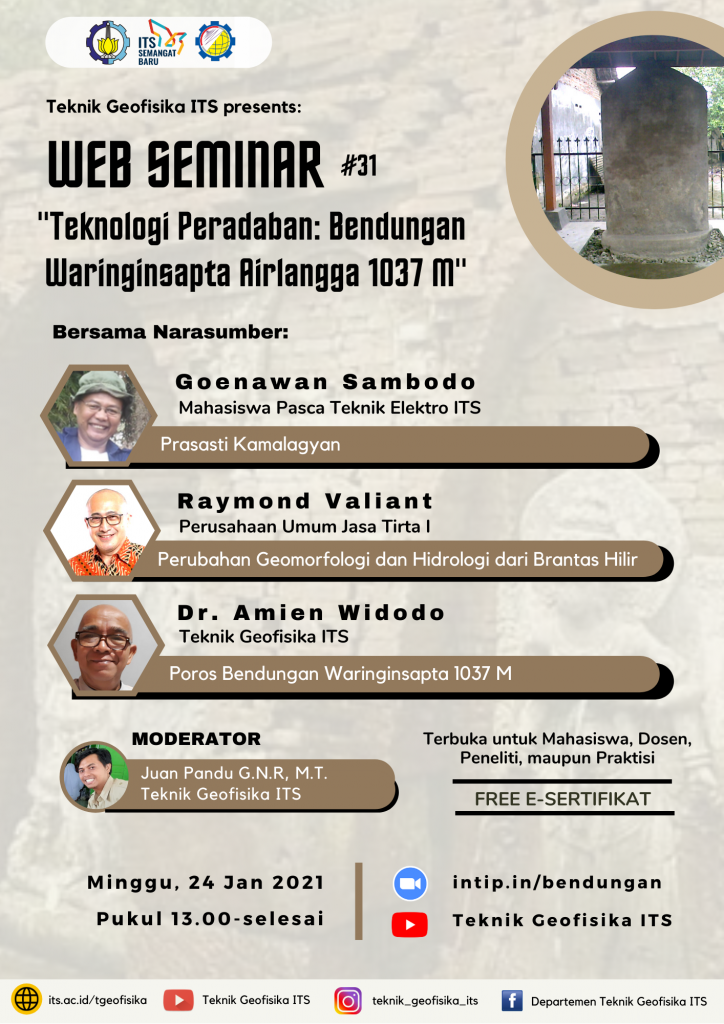Webinar “Teknologi Peradaban: Bendungan Waringinsapta Airlangga 1037 M”
Information
Based on data from BBWS Brantas (2011), the Brantas River Basin is a nationally strategic river area located in East Java Province at 110 ° 30 ‘east longitude to 112 ° 55’ east longitude and 7 ° 01 ‘latitude to 8 ° 15’ latitude. ± 320 km long and has a catchment area of ± 14,103 km2. The average rainfall reaches 2,000 mm / year, about 85% falls during the rainy season so that the potential for surface water per year averages 13.232 billion m3.
The source of sediment that entered the Brantas River was from the eruption of Mount. Kelud which had erupted long before the Majapahit kingdom and is known to be active until now. Serat Pararaton reported that the eruption of the mountain in 1233 Saka (1311 AD), the roar of cold lava (thunder banyu moved) in 1256 Saka (1334 AD), the emergence of the new (new) mountain in 1307 Saka (1385 AD), the mountain erupted in 1317 Saka (1395 AD) M), the volcano erupted in 1343 Saka (1421 AD) followed by food shortages in 1348 Saka (1426 AD), earthquake (Palindu) in 1372 Saka (1450 AD) followed by a year later, 1373 Saka (1451 AD), the volcano erupted in 1384 Saka (1462 AD), another volcano erupted in 1403 Saka (1481 AD).
The Majapahit Empire built many dams and canals in the city. The water structure was specially made to tame the water of the Brangkal River. Because of this water structure, Majapahit lasted until the 15th century. K.Brantas floods are still happening, until now.
How did the kingdom before Majapahit deal with the flood? It turned out that Airlangga was able to conquer the K.Brantas flood by building the Waringinsapta dam (embankment). The success of this flood management technology is written in Prasasati Kemalagyan 1037 M located in Klagen Sidoarjo. The problem is that these inscriptions are written in old Javanese or Sanskrit and in general, many letters are worn or missing. To be able to read inscription writing, at least 3 stages are needed, namely writing and transferring the contents of the inscription, translating into old Javanese and finally translating into Indonesian. The results of the translation were then searched for the location of the dam that Airlangga had made in overcoming the flood in 1037.
Want to know more? Join the Webinar by ITS Geophysical Engineering Department:
Geophysical Engineering ITS, proudly presents:
Webinar: “Teknologi Peradaban: Bendungan Waringinsapta Airlangga 1037 M”
with Speaker:
-
Goenawan Sambodo (Mahasiswa Pasca Teknik Elektro ITS)
-
Raymond Valiant (Perusahaan Umum Jasa Tirta I)
- Dr. Amien Widodo (Teknik Geofisika ITS)
as Moderator:
- Juan Pandu G.N.R, M.T. (Geophysical Engineering ITS)
The event will be held on:
- Sunday 24 January 2021
- 03.00 WIB-drop
- Join Zoom: intip.in/bendungan
- Live Youtube: Teknik Geofisika ITS
Speaker’s presentation can be downloaded here:
- Perubahan Geomorfologi Dan Hidrologi Dari Das Brantas Hilir
- Hilir Sungai Brantas Pra Abad Ke-15 M
- Prasasti Kamalagyan
- Poros Bendungan Waringinsapta 1037 M
#Geophysical Engineering ITS
#Teknik Geofisika ITS
#Fakultas Teknik Sipil Perencanaan dan Kebumian ITS
#Faculty of Civil, Planning and Geo Engineering ITS
#Institut Teknologi Sepuluh Nopember

Latest News
-
Pertajam Keilmuan Petrofisikamu dengan Studi Kasus Di Dunia Oil and Gas, dalam PETROPHYSICS TRAINING 2025!
Teknik Geofisika ITS mengajak anda untuk mendalami pengetahuan dan masalah-masalah yang terjadi seputar Petrofisika dalam acara PETROPHYSICS TRAINING 2025.
-
Kuliah Tamu “Bahaya Geologi Penurunan Tanah Daerah Pesisir Pantai Utara Jawa”
Teknik Geofisika ITS menyelenggarakan Kuliah Tamu “Bahaya Geologi Penurunan Tanah Daerah Pesisir Pantai Utara Jawa” dengan mengundang narasumber dari
-
WEBINAR “CERITA SUKSES UGG KEBUMEN & UGG MERATUS”
Teknik Geofisika ITS dan Ikatan Ahli Geologi Indonesia (IAGI) menyelenggarakan webinar “Cerita Sukses UGG Kebumen dan UGG Meratus”, mengundang





